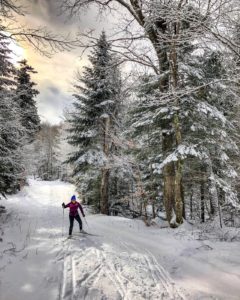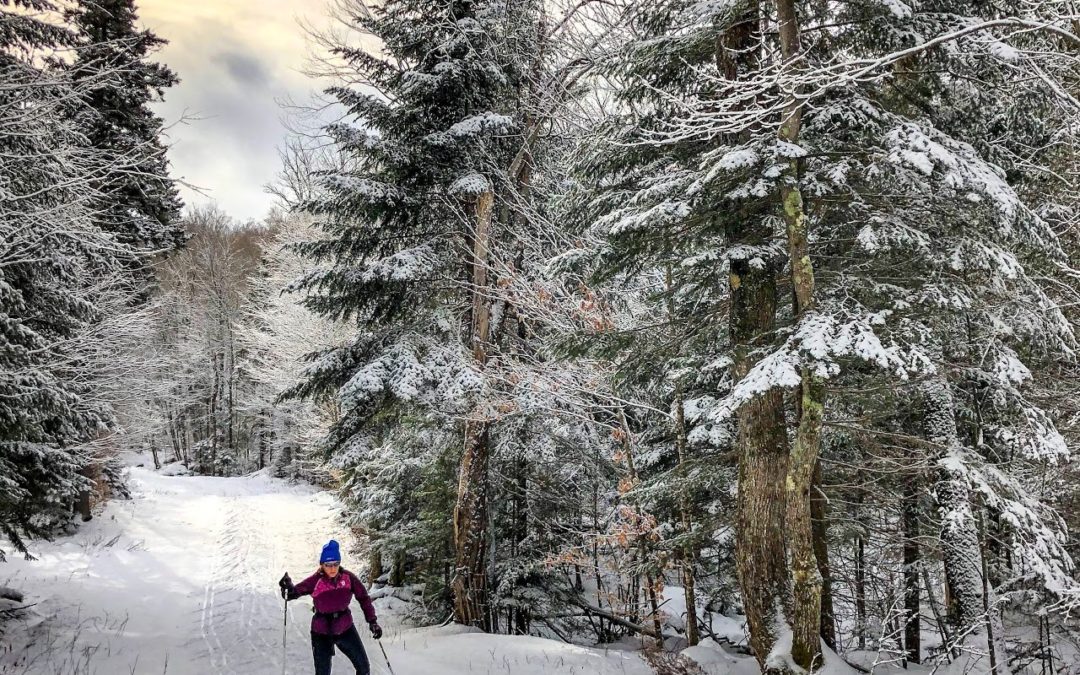By Lettie Stratton
Photo by phillip belena / Unsplash
Nordic or cross-country skiing is one of the most fun activities you can do during winter. There’s nothing quite like gliding through the white powdery stuff as you propel yourself forward, breathing fresh air and enjoying the natural environment around you.
Not only is Nordic skiing fun, it’s also excellent for your health. It’s a great way to combat stress, which can affect your sleep, increase anxiety, and cause a slew of other health issues. Cardio fitness is one of the best tools to use to fight stress and disease, and cardio exercise has even been linked to helping slow the effects of Alzheimer’s disease. Good thing Nordic skiing burns more calories than any other type of exercise!
The great thing about Nordic skiing is that it’s accessible for all ages and abilities. You don’t even have to consider yourself an athlete to get out there on the skinny skis and have some fun outside. While you certainly don’t need to have state-of-the-art ski gear to have a good time skiing, having a few essentials can help make your Nordic ski outing as fun and enjoyable as possible. Let’s take a look at how to properly prepare and gear up:
Skis, Boots & Poles
The basic gear for Nordic skiing consists of skis, boots, and poles. The first  question to answer is whether you’ll be classic skiing or skate skiing. Each type of skiing requires slightly different gear. There’s nothing more frustrating than trying to use the wrong type of gear for the ski technique you’re practicing.
question to answer is whether you’ll be classic skiing or skate skiing. Each type of skiing requires slightly different gear. There’s nothing more frustrating than trying to use the wrong type of gear for the ski technique you’re practicing.
Skate poles are longer than classic, for example, and the base of classic and skate skis are totally different. Each type of boot allows your foot to move in a different way to align with skate or classic technique.
For skate skiing, choose skate-specific boots, poles that come up to your upper lip or nose, and skis that are roughly forehead-high. For classic skiing, you’ll want classic-specific boots, skis that are about wrist-high when you raise a hand above your head, and poles that fall somewhere between your shoulder and armpit.
If you’re interested in trying both skate and classic skiing, combi boots are a great choice. A removable cuff allows you do try both techniques without changing boots.
There are also several different types of classic skis to choose from. Waxable skis use kick wax to grip the snow, depending on what temperature it is. On the no-wax side, you have fish scales or skins. Both have a slightly different way of gripping the snow without the application of wax.
Any good Nordic center or gear shop will help you find the right size and type of gear to suit your size, interests, and skill level. Don’t be afraid to ask questions!
Clothing
Nordic skiing differs from other winter sports in the sense that you don’t want bulky, puffy jackets and snow pants weighing you down. Instead, Nordic skiers depend on lightweight, breathable layers to keep them warm.
Since Nordic skiing uses pretty much every part of your body, you generally warm up pretty quickly, making bulky items unnecessary and cumbersome. Here’s how to dress for your Nordic skiing adventure:
Start with a base layer — a thermal shirt and long underwear makes a great start. On bottom, add a pair of Nordic ski pants over your long underwear. These usually have a tapered leg so the pants don’t get in your way when you move.
On top, a lightweight and breathable jacket followed by an optional water-repellant shell is a great combination. If you’re going to be out skiing for a while, you can bring a small daypack to put extra layers in if you get too warm or too cold.
Non-bulky gloves that will keep your hands dry are essential, as is a lightweight hat. You’ll also want sunglasses since the glare of sun on snow can be quite bright. Even on cloudy or overcast days, it’s important to protect your eyes from overexposure to UV rays. By following these general rules for how to dress, you’ll be well on your way to hitting the trails.
Preparation
Now that you’re dressed and have all the right gear, it’s time to think about preparing your body and your skis for the adventure ahead. Making sure your skis are waxed is essential for a successful outing. Even if you’re on no-wax classic skis, you still want glide wax on your skis so that they can perform to the best of their ability and not make you work harder than you need to.
If you don’t want to learn to wax your skis yourself, most ski shops or Nordic centers will do it for you for a fee. There is a lot of expensive and fancy wax out there, but you don’t need anything special to hit the trails. Just a few coats of a basic glide wax will do the trick.
If your skis are ready, then your body should be too. Make sure you’re hydrated before you go out, and even consider bringing a drink belt in case you get thirsty while you’re skiing. Bringing an energy bar or small snack in a pocket can be a good idea as well.
Finally, make sure you’re either familiar with the trail system or that you have a trail map and know the difficulty of the trails you’ll be encountering. If you’re at a Nordic center, ask the staff to recommend trails to match your skill level.
Nordic skiing is an incredibly fun lifelong sport — especially when you’re prepared. With proper skis, boots, poles, clothing, and gear preparations, all that’s left to do is hit the trails and enjoy yourself.



